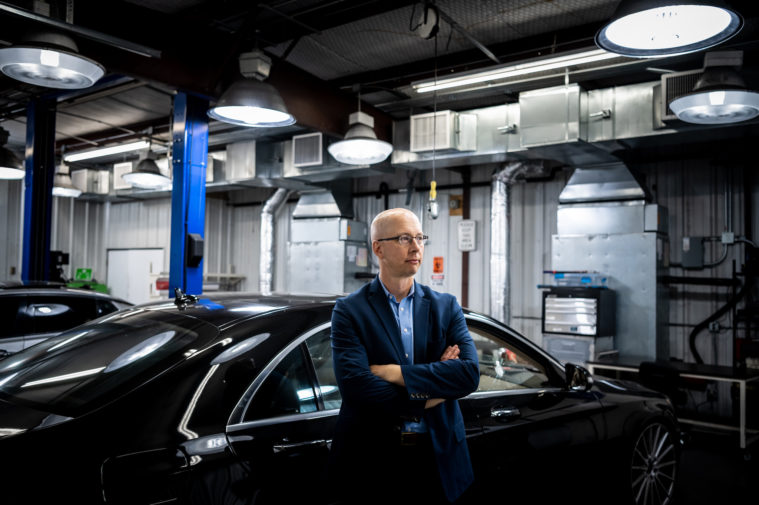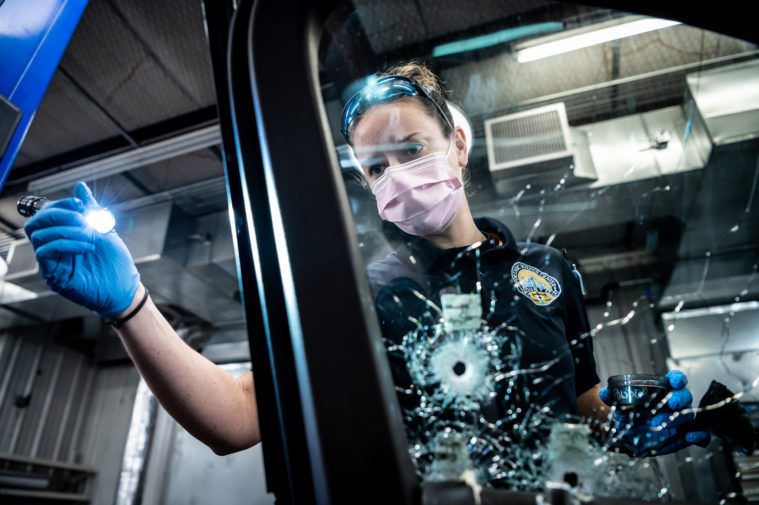Peter Stout’s buoyant presence cuts a sharp contrast to his grisly work as head of the Houston Forensic Science Center. Defying the typical laboratory white, Stout is dressed in hues of blue with bright teal armadillo socks peeking out of brown Oxfords.
His independent crime lab, dubbed the country’s worst in local and national news reports in the 2000s, separated long ago from its roots within the Houston Police Department. Under Stout’s leadership, it has transformed from a failed forensic lab with a leaky roof, staffed with under-qualified employees who lied about their credentials, and caused wrongful convictions into one of America’s most independent and respected public crime labs.
The lab’s daily churn includes analyzing evidence from some of the city’s worst crimes: murders, shootings, rapes. Stout doesn’t forget that each item can be vital. “When these events happen, they fundamentally change people,” Stout said. “What goes on in these labs is that little piece of objective information that means the difference of whether a family gets to start healing or not.”
“What goes on in these labs is that little piece of objective information that means the difference of whether a family gets to start healing or not.”
Stout occasionally finds himself questioning techniques used in Harris County courts, which have been plagued by catastrophic case backlogs produced both by Hurricane Harvey and the pandemic. He recently took a stand against the local district attorney’s risky method of introducing prior convictions in court, which relies on a fingerprint examiner from the sheriff’s department rolling the defendant’s prints and conducting an eyeball comparison with paper fingerprint records from older convictions involving people with the same name. “This leaves the examiner doing an exam in the situation that is the definition of suspect-driven conclusion bias,” Stout said.
Recently, the sheriff’s department suggested the Houston lab’s fingerprint examiners do those comparisons. Stout refused. “I’m not going to do that procedure,” Stout said. “It’s wrongheaded. It’s just asking for problems.”
For Stout, standing up for proper forensic procedures is personal.
In 1977, in the Westlake Hills area west of Austin, a couple interrupted a home burglary in progress. The attempted thief beat the couple, battering the husband to death in the driveway. The wife survived, but barely, and was left unconscious outside. They were Ivan and Cornelia Stout—Peter Stout’s grandparents.
The suspected murderer, Kenneth Felder, was shot later that day by his estranged wife. Police found Stout’s grandfather’s wallet in Felder’s back pocket and the suspected murder weapon—a .22 rifle with a broken stock—in the cab of his truck. Officers also found latent prints inside the truck they tied to a 21-year-old Black woman who knew Felder. Those prints, coupled with Stout’s grandmother’s eyewitness account, led to the woman’s conviction.

But the arrest relied heavily on archaic fingerprint analysis of prints found in the truck—not on any stolen item or on the murder weapon. The woman spent five years in prison before her murder conviction was overturned.
Stout still worries that the analysis was flawed. “This is part of the reality of it,” Stout admits. “I will never know if my family was complicit in a wrongful conviction.”
Back in the 1970s, the FBI established the basis for its more reliable computerized fingerprint database, called the Automated Fingerprint Identification System, but it wouldn’t be widely searchable until the 1990s. DNA profiling wouldn’t be used to solve a crime until 1986, and when it was, the world cried out for more accountability for forensics, which became more powerful as technologies advanced.
Stout continues to call for accountability in forensic tests through his own work. “The irony of it is that I am probably happier dealing with the stress and horror of a place like this than other things. Because it feels like I’m actually doing something,” Stout said.
As a result of his principles and lab policies, Stout and his employees avoid what they consider dubious forensics. When asked to take over the police department’s polygraph operations, the lab’s board refused given that the so-called “lie detectors” have so little scientific merit that they are not permitted in federal courts at all. The lab also declines to conduct “trace tests” such as comparing samples of a suspect’s hair or clothing fibers to samples found at crime scenes—tests that he says are costly to get right and have been tied to wrongful convictions.
“Our hope was that we were creating a model that other jurisdictions would emulate.”
At least 179 Texans have been exonerated since 1993 because of flawed or misleading forensic evidence, according to a national registry kept by the University of Michigan School of Law. Of those, 115 were in Harris County.
The Houston crime lab, like many others nationwide, used to be part of the Houston Police Department, but that arrangement ended in scandal. “As a natural course of things, the lab analysts would have access to information that as a neutral lab, you shouldn’t. And it might put the thumb on the scale a little bit about what results were expected,” said Bob Wicoff, a criminal defense attorney now with the Harris County Public Defender’s Office.
In the 2000s, lab officials came under fire for “scientifically unsound” practices. Several lab employees were fired and, at one point, the lab was forced to partially shut down amid “significant and pervasive” problems with the DNA and serology tests it conducted. Wicoff and others represented multiple exonerees who had been wrongfully convicted because of the lab’s poor practices—including Josiah Sutton, who was freed in 2004 after serving four and a half years of the 25-year sentence for a rape he did not commit.
Ultimately, Wicoff and others reviewed hundreds of cases and reforms followed.
In 2014, city officials cleaved the lab from the police department and established an independent board of directors to oversee it. The founding board included exoneree George Rodriguez and Nicole Casarez, a lawyer renowned for helping to free an innocent man from Texas’ death row. “The board members were responsible for hiring scientists to run the lab. So the lab would be run by scientists, overseen by a diverse board… and accountable to the citizens,” Casarez said.
That board hired Stout.

“Our hope was that we were creating a model that other jurisdictions would emulate,” Casarez said. “And for whatever reason, I don’t think that’s really happened.”
Today, the Houston lab employs 212. It extensively trains all employees and conducts rigorous quality assurance tests. It remains the only independent lab of its kind in Texas.
But that may soon change. Last year, Austin leaders prepared to separate its forensics lab from the police. (A state law penalizing jurisdictions that “defund” police departments later caused the city to reverse its decision, but officials recently recommitted to that reform). “The hallmark of high-functioning forensic science provision is independence,” Jennifer Laurin, a criminal law professor at the University of Texas, told Austin public safety commissioners.
Stout has advised Austin officials on how independence might look. He hopes calls for more independence and accountability in forensics will help raise other labs—and the discipline—to a higher standard.
“The opportunity to come be a part of this very unusual thing—attempting to make a difference with a lab that has been the archetype of the failed laboratory worldwide—that at least gives a hint that the pain is worth something,” he said.







